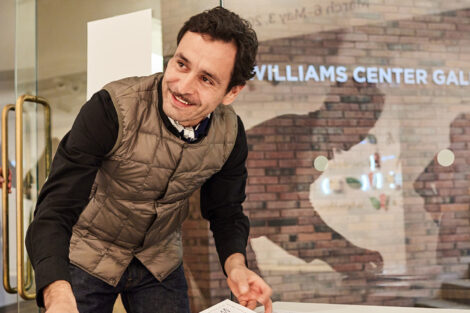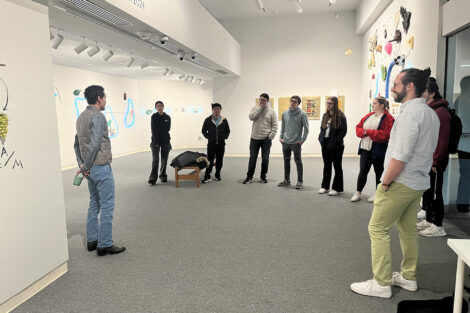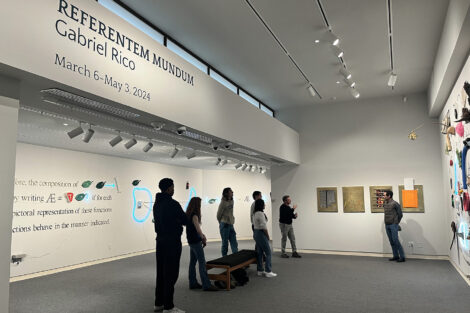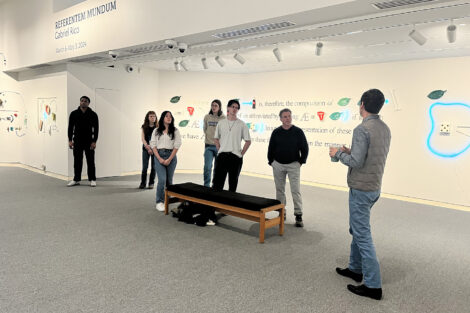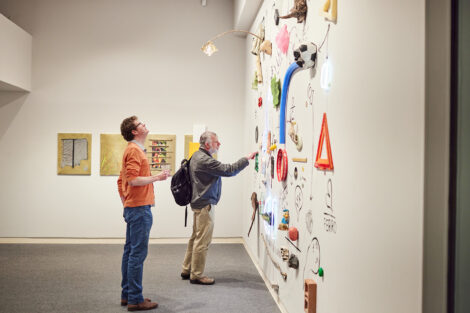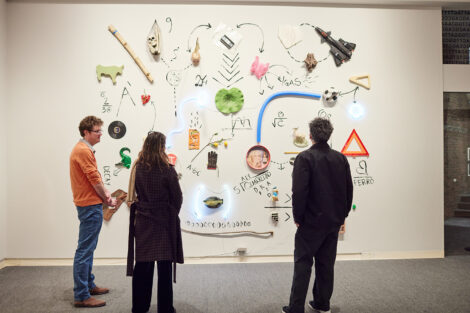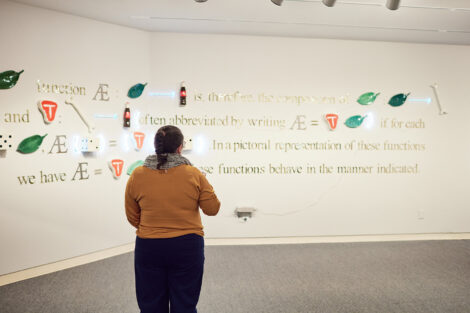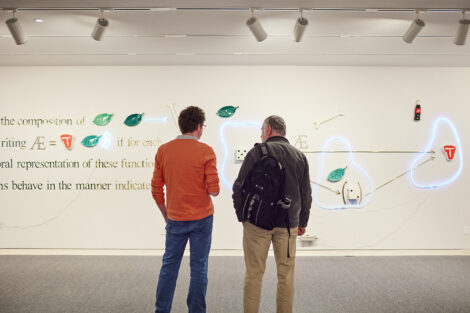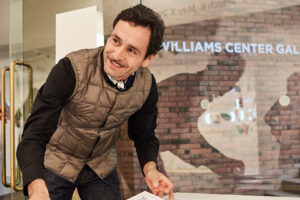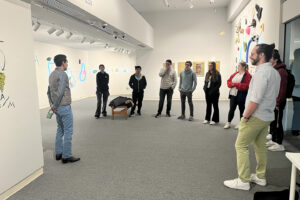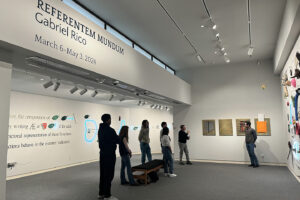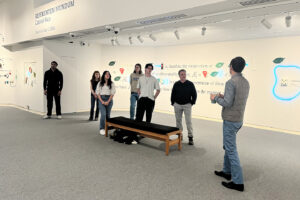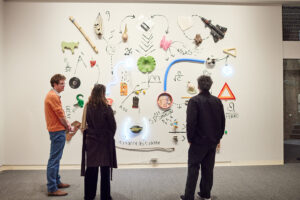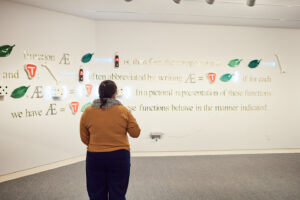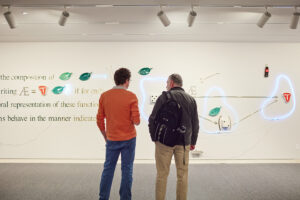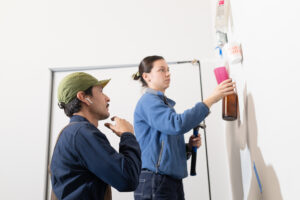Contemporary artist Gabriel Rico’s exhibit Referentem Mundum is now on display in the Williams Center Gallery at the Williams Center for the Arts. Translating to “calculating the world,” Rico’s exhibit explores connections between art and mathematics. His creative process parallels topology, a Mathematics branch that investigates the organization and structure of spaces in relation to their position.
I define myself as a contemporary artist, a multidisciplinary one. I use my life as meta to explore my humanity, and in that way try to fragment my perception of life by doing art.
Five works make up the exhibit, four of which were composed by Rico himself. The fifth mural is the only one produced in the exhibit that was collaboratively created from locally sourced items at Lafayette College during the artist’s residency.
The collaborative workshop took place across a span of four days at the end of February. On the first day, Rico spoke to the participating students about the ways art and mathematics connect, and how he has leveraged these connections when producing this series of works, which serve as his introduction to working with topology.
Student collaborators* were asked to think about mathematical equations or symbols that they found interesting in preparation for the second day of the workshop where they began to source materials for the collaborative art piece.
As they scouted their path toward the Karl Stirner Arts Trail, the group found a variety of items largely make up the mural installation, along with a few personal items contributed by participants.
Director of Galleries and Curator of Collections Ricardo Reyes, who curated the show, shared more about the importance of found objects to Rico’s artistic vision.
“Gabriel, what he does is he uses the symbols and the equations as his artistic vocabulary,” Reyes said. “He adds that to the found objects so that the found objects become synthesized with an idea. It’s no longer just an object from nature, but it’s an object to use as art material.”
The group’s found objects include various cans and bottles, an orange umbrella, a maroon scrunchie, a hand warmer, batteries, a box of cigarettes, a foam cup of ramen, and various natural elements such as branches and remnants of a bee hive all arranged into interconnected equations.
While some of the items stand alone, many were used to resemble parenthesis and other mathematical symbols. Rico explained that once you recognize that the symbols you want to represent have very specific shapes, you can look for those shapes in found objects. “It’s very easy for the brain to have that perspective once you realize the different shapes of the symbols,” he said.
Rico shared that the found objects are unique to the surrounding area at the college, but also speak to larger ideas about human nature, namely the Anthropocene and the effects of human activity on the environment we live in.
“Everything is more about humanity, and how Lafayette students are part of a society, and the society is part of the human race,” Rico said. He added that interpreting art is all about “zooming in and out on the things you want to realize.”
Arrows and other symbols like rain clouds, lightning bolts, and stars drawn in black paint serve to connect all of the different elements in the collaborative mural. Rico stated that all of these arrows between the “crazy combinations of things” on the wall came from his idea, reminiscent of the way scientists and mathematicians use arrows and symbols to connect different elements when writing out long and complex problems on the blackboard.
“Art is always seen as isolated,” Reyes said, “but in actuality, artists are very much connected…We bring artists in to help facilitate the participatory aspect of it, so students can meet with an artist, talk with an artist, help install, and do workshops,” and in this way, he explained how art has become a very participatory discipline on campus.
The workshop exemplified the interconnectivity of art and how it overlaps with many other academic disciplines, where science and art worked together to create a cohesive piece. The collaborators involved in the workshop came from majors outside of art, namely mathematics and psychology. The value of a liberal arts education is often measured by a well-rounded experience on campus, as demonstrated by the workshop.
Rico said the workshop with Lafayette students taught him the importance of slowing down.
“When you try to find objects, the walking speed is very important because you can really stop and look around and recognize things,” he said. “It’s very difficult to recognize things if you run.”
He also explained that walking at a slower pace to find objects made it easier for the participants to connect, stressing the importance of connections not only between disciplines at the college but also between people inside and outside of the Lafayette community.
“Really at the end, we are the same,” Rico said. “We share visions of creativity.”
The exhibit will be on display from March 6 through May 3, and the collaborative mural will become part of the college’s permanent art collection at the end of the exhibit.
“It’s very important for me to be here, to be part of the cultural agenda of the college, because education is very important,” Rico said. “Normally my work is related more with museums or public institutions, but not too often can you see my work in educational institutions. This is a very special moment for me.”
*student collaborators: Christopher Rafferty ‘26, Kendall Shaw ‘26, Yunting Jiang ‘25, Isabella Lu ‘25, Sneha Khatuwala ‘27, Lily Dineen ‘24
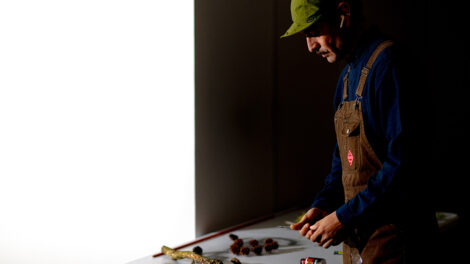
ARTIST TALK & RECEPTION
MARCH 7, 2024
4:30 PM | artist talk in Williams Center 108
5:30 PM | reception in lobby
